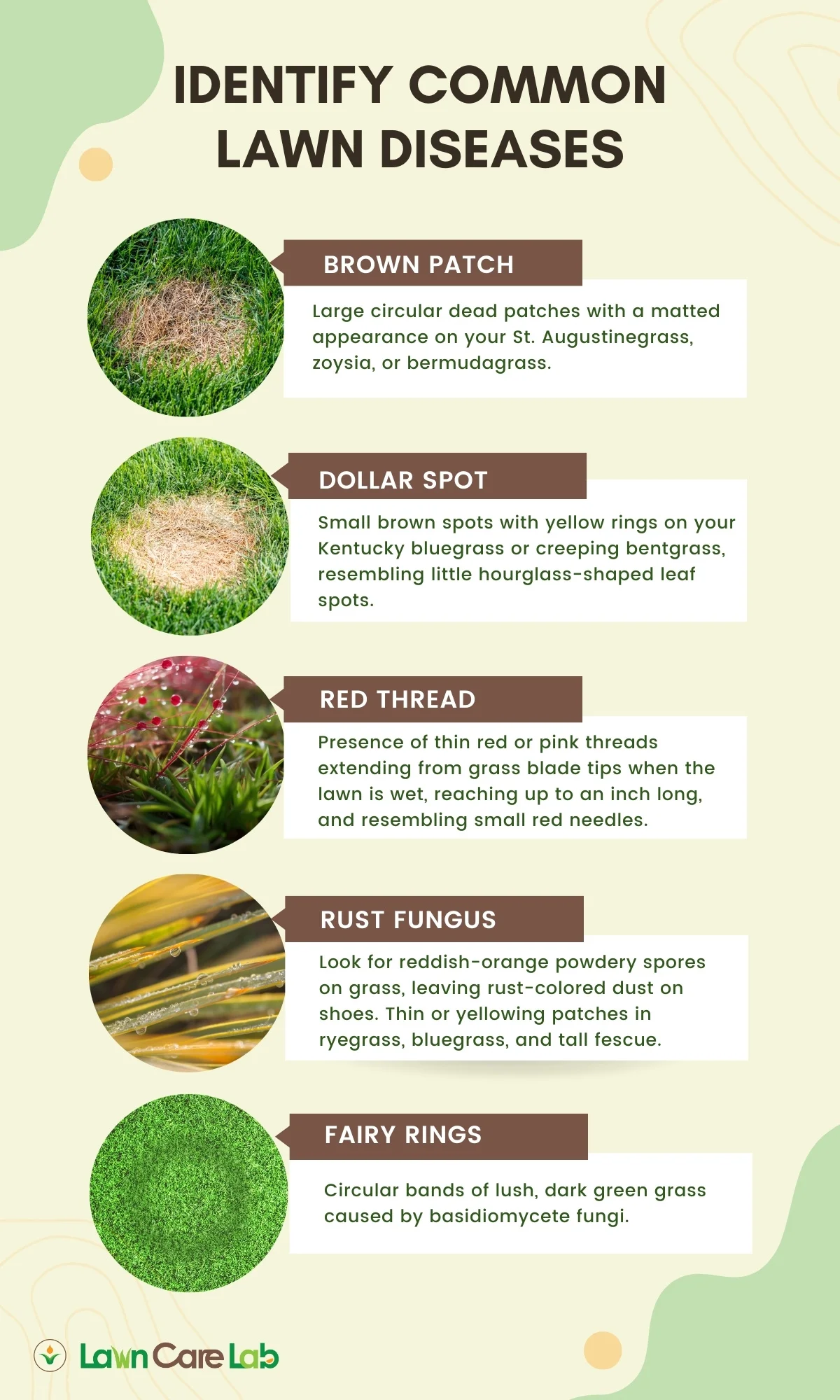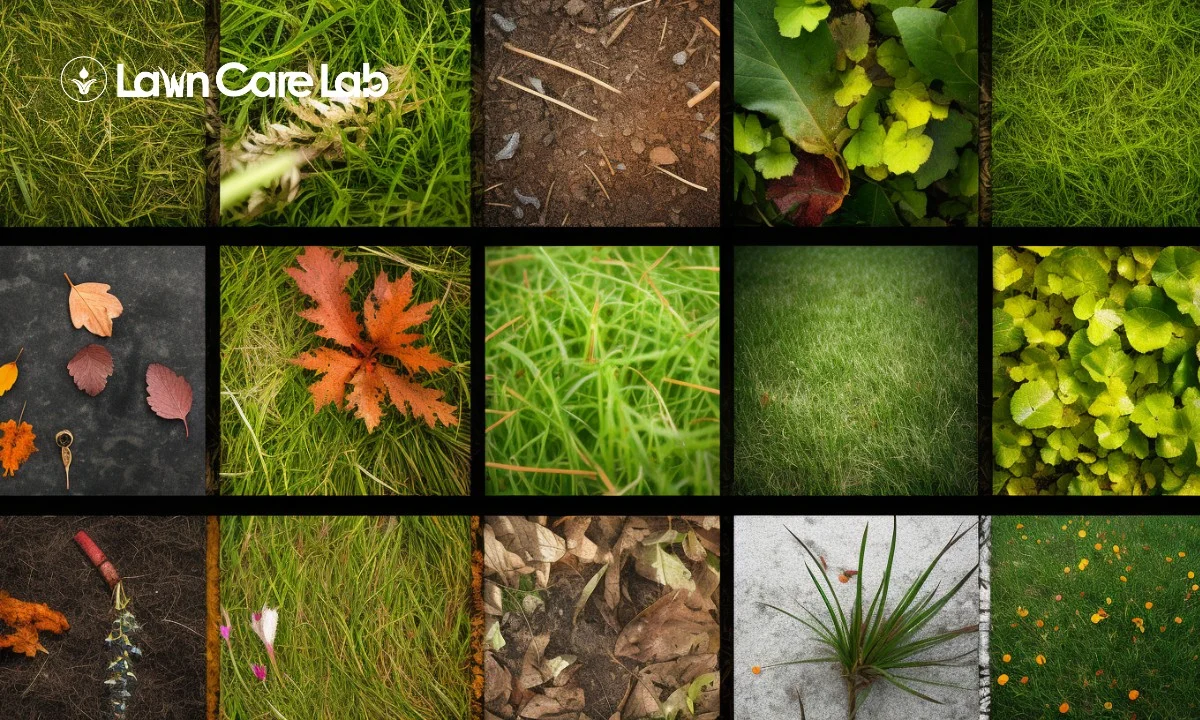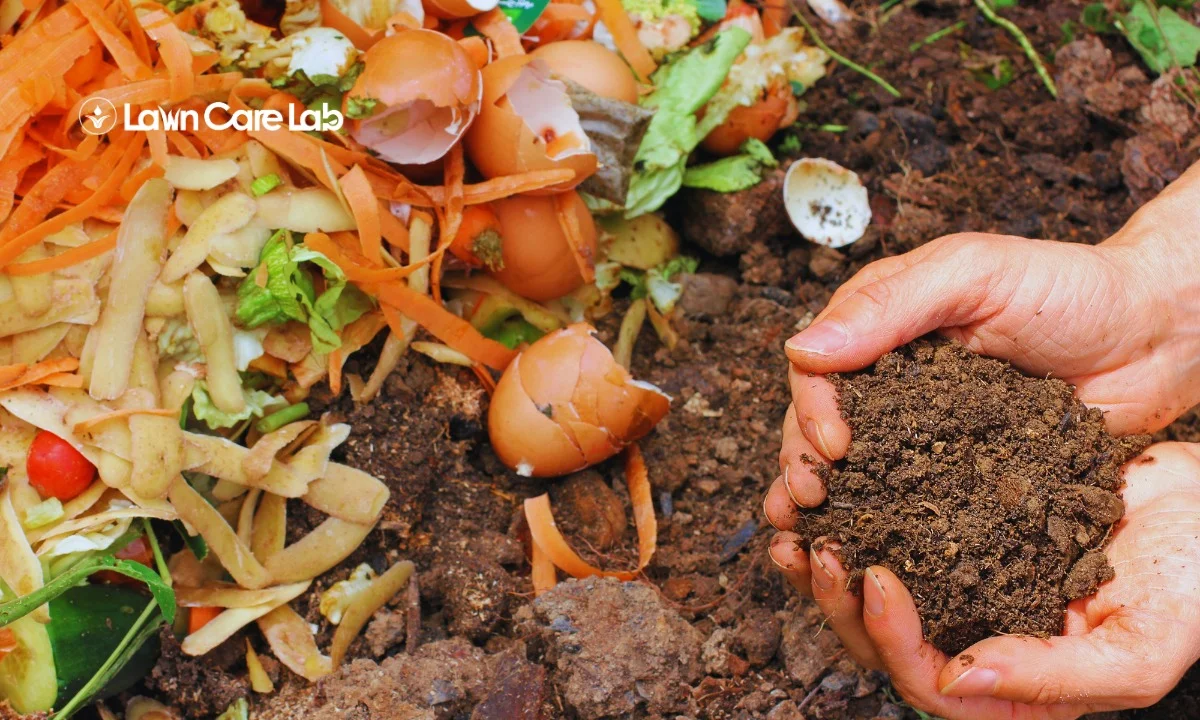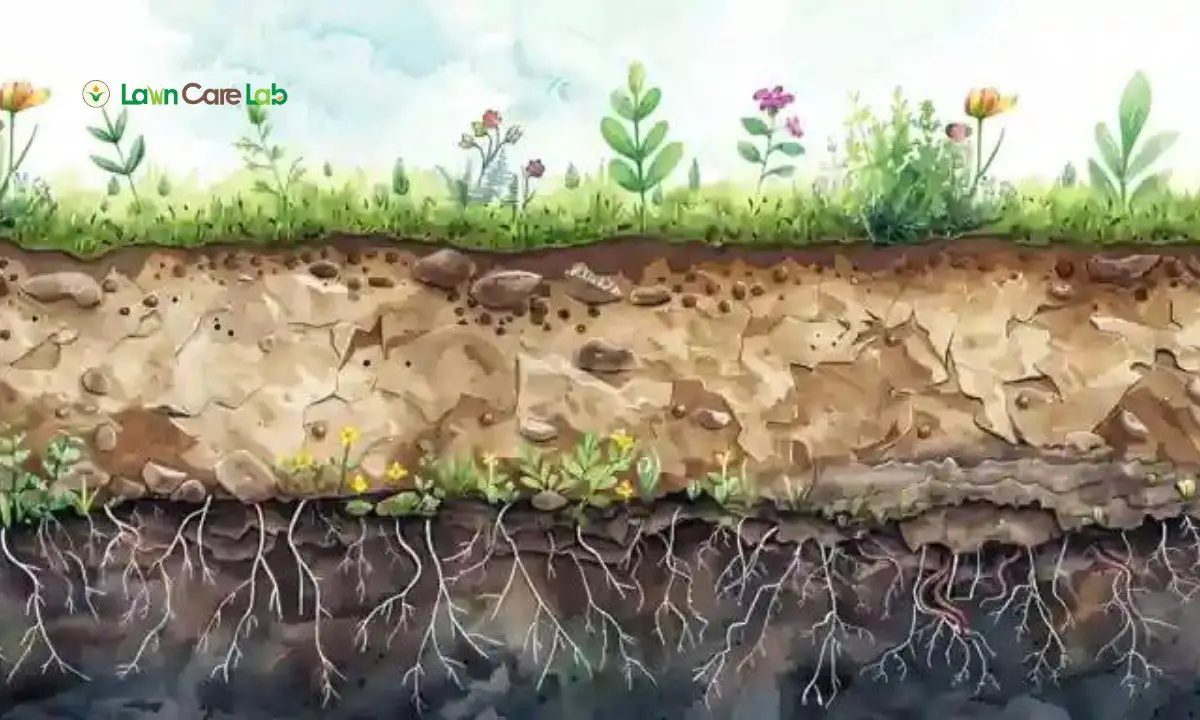Identifying common lawn diseases can be tricky, but with a keen eye and some basic knowledge, you’ll be able to spot them in no time.
Look for symptoms such as patches of discoloured grass, spots or lesions on the blades, or unusual growth patterns.
Take note of the time of year and weather conditions, as certain diseases thrive in specific environments.
In this article, we explained some common lawn diseases and their treatment.
Highlights
- Red Thread is identified by its pinkish-red color and thin, wiry strands. It is common in fescue lawns.
- Rust Fungus is characterized by rust-colored dust or powder on shoes and thin or yellowing patches in ryegrass, bluegrass, and tall fescue.
- Fairy Ring is identified by circular lush and dark green grass bands, typically found in drought-prone regions. Core aeration, surfactant application, and watering adjustment can be used for treatment.
- Small, circular straw-colored patches identify Dollar Spot and are common in warm, humid climates. It can be treated with fungicides like chlorothalonil or propiconazole, improved air circulation, and reduced thatch buildup.
Table of Contents
Lawn Disease Identification Chart
It is important to identify and treat lawn diseases before they can spread and damage large grass areas. Common fungal diseases like red thread, dollar spot, and brown patch can leave unsightly patches or dead areas if left unchecked.
Use the following lawn disease identification chart that provides pictures of the most common lawn problems. Compare the photos to what you see in your yard to diagnose the issue accurately. Treat lawn diseases right away to restore the health and beauty of your lawn.

1. Brown Patch
So, you’re on the hunt for those pesky brown patches in your otherwise lush lawn, huh?
Well, let me tell you – spotting them is an art form!
Brown Patch Signs
You’ll feel your heart sink when you spot the telltale signs of Brown Patch, such as large circular dead patches in your St. Augustinegrass, zoysia, or bermudagrass that have taken on a matted appearance.
It’s like looking at a bad haircut on an otherwise perfectly coiffed poodle.
First, the brown patch lawn disease takes no prisoners – ruthless!
Second, these death circles can expand up to 10 feet. That’s larger than a sumo wrestler!
Third, the grass doesn’t just die; it gets matted down like it’s been styled by a drunk hairdresser.
Brown Patch Treatment
Once you’ve identified brown patches as the culprit behind your lawn disease, it’s time to take action. Don’t worry; we’ve got you covered with innovative solutions to restore your yard to its former glory.
First, grab a fungicide that contains propiconazole or myclobutanil. Consider it an elixir for your green buddy. This will help combat the brown patch and get your grass back on track.
Next, it’s important to improve sunlight penetration and airflow. Give your lawn a refreshing haircut by pruning any overhanging foliage. This will allow more sunlight to reach your grass and promote better airflow, which can help prevent the spread of the disease.
In addition to pruning, adjusting your watering routine can make a big difference. Encouraging deeper roots by watering less frequently but for longer periods of time can help your grass become more resilient to brown patches.
2. Dollar Spot
You know those little silver-dollar-sized spots on your lawn that make it look like it’s auditioning for a Dalmatian role?
That’s the pesky dollar spot disease.
We will show you how to catch the rascal red-handed and kick it out of your yard party.
Dollar Spot Indicators
Spotting small brown spots with yellow rings on your Kentucky bluegrass or creeping bentgrass could be a telltale sign of Dollar Spot, a common lawn disease.
Don’t worry! This isn’t the universe telling you that your lawn has suddenly become worthless as a dollar. It’s just dealing with the pesky dollar spot lawn disease.
But how can you be sure?
Whip out your smartphone and pull up some lawn disease pictures for comparison. If those little hourglass-shaped leaf spots in your yard look like the lawn diseases with pictures you see online, then bingo: You’ve got a classic case of the brown spot lawn disease!
Dollar Spot Treatment
With the right approach, conquering this pesky dollar spot disease is doable.
First things first, let’s up our lawn disease identification game. Grab your magnifying glass and start examining your turf like a detective on CSI: Lawns!
See those small white spots? That’s our enemy!
Time for some dollar-spot treatment action. Get yourself fungicides with chlorothalonil, propiconazole, or iprodione.
Remember not to over-fertilize with nitrogen; we’re growing grass here, not Hulk’s muscles!
And ensure good soil drainage through aeration – it’s like giving your lawn a nice deep breath of fresh air!
3. Red Thread
Ready to delve into the crimson mysteries of Red Thread, that pesky lawn disease?
We will unmask this villain’s telltale Rust Fungus symptoms and arm you with fail-safe treatment strategies.
Buckle up, champ – it’s time for some gardening CSI!
Red thread Symptoms
The red thread is a lawn disease that causes irregular patches of grass to turn pink or red.
The most identifiable symptom is the presence of thin red or pink threads that extend from the grass blade tips when the lawn is wet.
These threads can reach up to an inch long, shrivel, and darken as they dry out, resembling small red needles.
The grass in the affected areas may appear water-soaked or greasy and have a pink cast.
The disease primarily affects the leaf sheaths and blades rather than the roots or crowns, so the grass usually recovers.
Red Thread Treatment
When you think of what red thread lawn disease looks like, imagine your lawn preparing for Christmas way too early with tiny red tinsels.
| Red Thread Identification | Description |
|---|---|
| Color | Pinkish-red |
| Texture | Thin, wiry strands |
| Location | Common in fescue lawns |
Meet the infamous red thread rust lawn disease. To combat this unwelcome holiday spirit, improve soil drainage and aerate compacted soils.
Apply phosphite fungicides come springtime and overseed with some tough-as-nails fescue.
So next time you consult your lawn disease identification chart and spot the notorious red thread disease in lawns, remember – don’t let it ruin your summer fiesta!
4. Rust Fungus
You’ve stumbled upon rust fungus; this sneaky little disease has made itself home in your grass.
But fear not! We will delve into the tell-tale symptoms and treatments for this unwelcome guest. We’ll give you all the tools to show it the door.
Rust Fungus Symptoms
Got a case of the ‘lawn measles’? Your turf likely suffers from rust fungus, a common disease that manifests as reddish-orange powdery spores on grass! Recognizing this pesky lawn disease is half the battle. So, whip out your lawn disease identification chart and compare pictures of lawn diseases.
Here are some tell-tale signs:
- The rust-coloured dust or powder on your shoes after walking over the grass. This is no ordinary fairy dust; it’s a classic symptom of lawn fungus!
- Unusually thin or yellowing patches in ryegrass, bluegrass, and tall fescue. Sure sign you’re dealing with our old friend: Lawn Disease Rust!
So don’t panic when spotting these symptoms. Remember, knowledge is power in tackling any ‘measles outbreak…in your yard!
Rust Fungus Treatment
When your green oasis starts wearing a rusty coat, it’s time to roll up your sleeves and declare war on this fungal foe with the help of azoxystrobin and propiconazole fungicides.
Strike a balance in nitrogen fertilization; you don’t want to be overly generous here.
A well-drained soil with adjusted pH is also crucial in your battle strategy against rust fungus.
Here’s a quick peek into our ‘lawn disease identification chart’ –
| Disease Name | Identification |
|---|---|
| Rust Fungus | Rusty Coat on Grass |
| Disease X Lawn | Yellowing patches |
| Summer Patch Lawn Disease | Circular brown patches |
| Pests & Diseases | Insect damage, irregular patches |
Remember, identifying the right lawn pests and diseases is crucial for an effective rust fungus treatment.
5. Fairy Rings
Oh, stumbled upon a mystic fairy ring on your lawn, have you?
Let’s dive into this enchanting world where we’ll decode the signs of fairy ring marks and arm ourselves with effective treatments to keep our lawns from becoming an enchanted forest.
Fairy Ring Marks
You’ll want to watch for Fairy Ring Marks in your mission to maintain a pristine lawn.
These are telltale signs of basidiomycete fungi that manifest as circular bands of unusually lush and dark green grass.
These bad boys are like the crop circles of spring lawn diseases, leaving their mark in drought-prone regions.
If you’re thinking, ‘Fairy ring disease in the lawn is caused by cheeky fairies’, sorry to burst your bubble!
It’s all due to pesky soil-dwelling fungi that love playing hide and seek at the root level of your grass.
Fairy Ring Treatment
So, you’ve spotted those pesky Fairy Ring Marks, and now it’s time to roll up your sleeves and dive into the nitty-gritty of fairy ring treatment.
Don’t worry; we won’t let you battle this lawn red thread disease alone!
| Action | Description | Result |
|---|---|---|
| Core Aeration | Breaks up fairy rings | Breathable soil |
| Surfactants Application | Destroys surface tension | Healthy grass growth |
| Watering Adjustment | Discourages fungus growth | Disease-free lawn |
Start by giving your turf a good ol’ core aeration – think of this as giving your lawn acupuncture.
Next, apply surfactants like you’re painting a masterpiece; these bad boys break the surface tension.
And finally, adjust watering practices – too much H2O encourages fungal fiestas.
Conclusion
Now that you know how to identify and treat common lawn diseases, you’re ready to take control of your lawn’s health.
Remember to maintain proper lawn care practices, such as regular mowing, watering, and fertilizing, to prevent these diseases from taking hold. Happy gardening!
FAQs on Lawn Diseases
How do I know if my lawn has a disease?
What does lawn fungus look like?
What does a sick lawn look like?
What does grub damage look like?
What is anthracnose disease?
What is scab disease?
What is Downy mildew disease?
What is sorghum sickness?
What does grass tetany look like?
What does nitrogen deficiency look like in lawns?
What does a stressed lawn look like?
- How to Create a Lawn Care Schedule for Southern Climates - October 30, 2024
- How to Use Compost Tea to Boost Lawn Growth and Soil Health - October 23, 2024
- The Best Grasses for Saltwater-Exposed Lawns: Coastal Lawn Care - October 17, 2024




